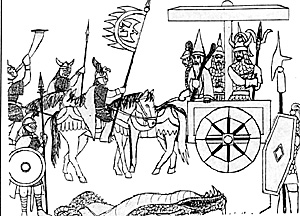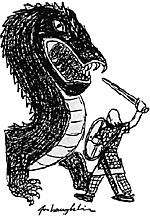 When TSR's Diablo II: The Awakening was about to hit the stores, the scuttlebutt on the Internet was that the book came with large random tables that would allow over 1,000,000 different items. Being a big fan of random tables of all kinds, I decided to check it out for myself. So I stopped into one of my two local game stores that I frequent (this one I mainly hit for RPG books, while the other provides most of my wargaming figures), found a copy of the book in the "newly arrived" rack, and flipped through it. Let's see; it is an adventure/supplement for 2nd edition AD&D, which is OK, as I have the player's and dungeon master's handbooks courtesy of a friend, as well as the Core Rules CD-ROM, courtesy of myself. It comes with five new character kits, based on the characters from the Diablo II computer game. It comes with new spells. Ah, here's the random item list. Pretty impressive. Yes, I like it. What next... ah, over 100 new monsters. Wow, they look powerful. OK, then maps with monster locations, etc. for the entire original Diablo computer game. Huh. Guess they didn't want to give away anything from the new game, so they went with the old one. OK, I'm fine with that. So I bought it, mainly for the item table. I was planning on putting this with the other RPG books I have purchased with no real intent to play them. Why do I do this? I'm a gamer; I don't need a reason.
When TSR's Diablo II: The Awakening was about to hit the stores, the scuttlebutt on the Internet was that the book came with large random tables that would allow over 1,000,000 different items. Being a big fan of random tables of all kinds, I decided to check it out for myself. So I stopped into one of my two local game stores that I frequent (this one I mainly hit for RPG books, while the other provides most of my wargaming figures), found a copy of the book in the "newly arrived" rack, and flipped through it. Let's see; it is an adventure/supplement for 2nd edition AD&D, which is OK, as I have the player's and dungeon master's handbooks courtesy of a friend, as well as the Core Rules CD-ROM, courtesy of myself. It comes with five new character kits, based on the characters from the Diablo II computer game. It comes with new spells. Ah, here's the random item list. Pretty impressive. Yes, I like it. What next... ah, over 100 new monsters. Wow, they look powerful. OK, then maps with monster locations, etc. for the entire original Diablo computer game. Huh. Guess they didn't want to give away anything from the new game, so they went with the old one. OK, I'm fine with that. So I bought it, mainly for the item table. I was planning on putting this with the other RPG books I have purchased with no real intent to play them. Why do I do this? I'm a gamer; I don't need a reason.
So I get home after church choir practice that night, and I go out on the back deck with a frosty from Wendy's, and read through the book. That's when it hits me. Everything is laid out, from where creatures are encountered to where all the barrels and crates are. This looks like it would play exactly like the computer game. I mean, you can smash open crates and barrels and find stuff inside them, just like the computer game, for crying out loud. In fact, almost everything is either mapped out, randomly determined, or can be randomly determined. This sucker is dying to be played solo, as the computer game can be played that way. It's mainly a character-based wargame, not a real role-playing game. I guess it could be played with real role-playing, but considering the note in the intro, "Suddenly, I understood.
After weeks immersed in the DIABLO game, I finally caught on that the DUNGEONS & DRAGONS game is about "accumulation." (author's emphasis) See, the author admits that it isn't about role-playing, it's about whacking demons and undead and finding cool stuff. So, I promptly rolled up four characters to delve into the first level of the Diablo dungeon. Why four? I don't know. I just like the number four, I guess. I randomly determined their character kits from the seven available in the game. These are the fighter, thief (rogue), amazon, barbarian, paladin, necromancer, and sorcerer. The first two are the basic fighter and thief from the AD&D player's handbook, while the remaining five are new. I got a fighter, a thief, an amazon, and a necromancer. So, I took my intrepid adventurers into the town of Tristam, where the monastery housing the dungeon is located. They bummed around a little bit, and then they headed down into the depths.
 Each level of the dungeon (there are 16 in all) is laid out in detail in the book. The maps visually show where everything is located. Every monster, every barrel, every stairway, every pillar. You will have to decide how to go about determining what path your adventurers take, and what monsters they run into. I decided to randomly pick their path, and I ruled that they could see monsters when they were three "squares" away on the map. This was pretty much an arbitrary decision, though the book does note that on the first few levels lighting is very spotty, so it does make some sense. I also streamlined combat by assuming that my characters always had initiative in every round. Yes, it gave my characters an advantage, but they will likely be outgunned a lot, especially in the beginning, so that didn't bother me too much. Consider it an equalizer, though you of course could do it however you wanted. I also assumed that my missile weapon-equipped characters would have 1 round to shoot at oncoming creatures before they closed to melee range. This isn't really accurate, as I should go with the speed characteristics given, but it is a nod to simplicity. You could of course use the speed characteristics as given to get a better feel for different monster movements. Also, when generating characters, I didn't bother with alignment and other "extras" that really don't come into play here.
Each level of the dungeon (there are 16 in all) is laid out in detail in the book. The maps visually show where everything is located. Every monster, every barrel, every stairway, every pillar. You will have to decide how to go about determining what path your adventurers take, and what monsters they run into. I decided to randomly pick their path, and I ruled that they could see monsters when they were three "squares" away on the map. This was pretty much an arbitrary decision, though the book does note that on the first few levels lighting is very spotty, so it does make some sense. I also streamlined combat by assuming that my characters always had initiative in every round. Yes, it gave my characters an advantage, but they will likely be outgunned a lot, especially in the beginning, so that didn't bother me too much. Consider it an equalizer, though you of course could do it however you wanted. I also assumed that my missile weapon-equipped characters would have 1 round to shoot at oncoming creatures before they closed to melee range. This isn't really accurate, as I should go with the speed characteristics given, but it is a nod to simplicity. You could of course use the speed characteristics as given to get a better feel for different monster movements. Also, when generating characters, I didn't bother with alignment and other "extras" that really don't come into play here.
Basically, play comes down to visualizing the action in your mind, while rolling lots of dice to determine said action. Actually, that describes lots of games. Let me be more specific. Probably the first thing you will encounter when entering the monastery is a number of sarcophagi for you to open at your peril. If you decide to open them, you roll a D20, and reference the Treasure Sources chart on page 90. You will either find nothing, a skeleton will arise and attack you, you will find gold pieces, or you will find an item. If you find an item, you will roll on the Base Item Table on page 38. Actually, it never says this, but I imagine you should first roll on the item section of the Base Treasure Table on the same page, which determines whether you find a plain, generic item; or a magic item. Depending on which you find, you roll on a number of sub-tables to determine the exact characteristics of the item you found. You also roll on the Base Treasure Table every time you whack a monster, possibly delivering you some gold, or another item. The power of items you find is keyed to the level of the dungeon you are on, so you should find more powerful items on level 10, as opposed to level 2.
And that's about it. Your characters wander around, whacking anything that moves (well, most things, anyway), and some things that don't. You are there to purge the monastery of evil, not engage said evil in conversation. You stay down until you have had enough, or you get killed. And your characters will get killed. I have yet to lose an entire party, but I did lose 3 of my 4 in one trip into the monastery. That was a bad day. It actually is considerable fun, especially when you find something cool, like the orange gladius of the jaguar (a gladius that provides +1 to saves against lightning and provides the wielder an extra 8 hit points), or the awesome belt of warmth (+4 armor class, and limited immunity to cold). Flip through the random item table in a store and you'll see what I mean. Considering that D&D 3rd edition will be out by the time this gets printed, you may be wondering about playing in 3rd edition D&D. Well, a check of the www.wizards.com website shows that late in 2000 a product called Diablerie is to be released, which is supposed to provide 3rd edition stats for all the Diablo characters, spells, monsters, etc. I have no idea how it will expand on the information presented in The Awakening, but we'll just have to see.
 Now, if you actually want to roll up a party and delve into the monastery to whack the bad guys, here are some tips I have learned that may make things easier for you:
Now, if you actually want to roll up a party and delve into the monastery to whack the bad guys, here are some tips I have learned that may make things easier for you:
- 1. When generating characters, you don't need to figure out everything about your characters. I don't bother with alignment, secondary skills, height, weight, gender, names, etc. My amazon is "the amazon" and that's all that really matters.
2. I roll 4d6 for attributes and dump the lowest roll. There are other suitable methods, too, a number of which are detailed in the Player's Handbook.
3. For new characters, I always give them the maximum possible hit points, rather than rolling, as a character with one or two hit points will die very quickly.
4. My parties all have four members, and their class/type is randomly determined. You could use five or even six members, which should make things a little easier. I do not allow multiple characters of the same type, but that's just to force variety. You could have a party of six necromancers if you really wanted, though I wouldn't recommend it.
5. When equipping new characters, just use the equipment listed in the Base Items table, and let thieves (rogues) have thieving tools for free. All you need are weapons and armor. Don't bother with anything else, as I haven't seen any reason for having any of it. Just assume they eat at the inn in town.
6. When tables tell you to roll a D* plus the level of the dungeon you are on, I use the dungeon level -1. Therefore, on the first level you just roll the die, on the second level you roll a D*+1, on the third level you roll a D*+2, etc. I think this is what they intended, and what they put is an editorial glitch.
7. The Treasure Sources chart has tables for small and large chests. However, the maps just show one type of chest. I use the small chest table for dungeon levels 1 - 8, and the large chest table for levels 9 - 16.
8. I make liberal use of sticky notes in the book for use as bookmarks for constantly referred-to pages, and as notes for special situations like remembering which rumors have been told to the characters.
9. Photocopying the dungeon maps allows you to scratch out defeated monsters and explored areas, as well as keeping you from having to constantly flip in your book to the map.
10. I don't bother with initiative, and I just assume that my characters automatically have it, unless there is a good reason for assuming they don't (like they get ambushed). This does make some magic items in the game useless, but you can always sell them for money. Of course, you can also play with regular initiative rules.
11. Feel free to randomize as many things as you want, from dungeon encounters to PC actions. I make some of the decisions for my party, and randomize the rest. I determine when to randomize by how I feel at the time; I have no set method, though I normally randomize for direction taken, as I can see on the maps where the enemy creatures are.
12. As soon as possible, buy the absolute best armor you can. It comes in very handy.
13. In combat, I always say that my magic users are cowering behind the fighters until I decide they will venture into the fray. I learned this the hard way after randomly determining whom a skeleton archer would shoot at, and he pinned my Necromancer to the wall with one shot. This happened twice, after which I decided that the fighters should protect my magic users. This has worked much better.
I should note that Wizards of the Coast has also released the Diablo Adventure Game, which is a boxed game that is designed to introduce D&D to new players. I do not own a copy, but according to the box description it comes with playing pieces and actual dungeon floor tiles, so you can visually lay out everything. That would be really cool, but I didn't feel like dropping $20 just for floor tiles. However, if you want some table top Diablo action and don't already have the AD&D core rule books, this could be the way to go.
Well, that's about it. You should be able to figure out whatever else you need to play from the book itself, which does a good job of explaining how a Diablo/AD&D game should be played. Make sure you roll lots of 20s, and you should do just fine.
Back to Table of Contents -- Lone Warrior #132
Back to Lone Warrior List of Issues
Back to MagWeb Magazine List
© Copyright 2000 by Solo Wargamers Association.
This article appears in MagWeb (Magazine Web) on the Internet World Wide Web.
Other military history articles and gaming articles are available at http://www.magweb.com
